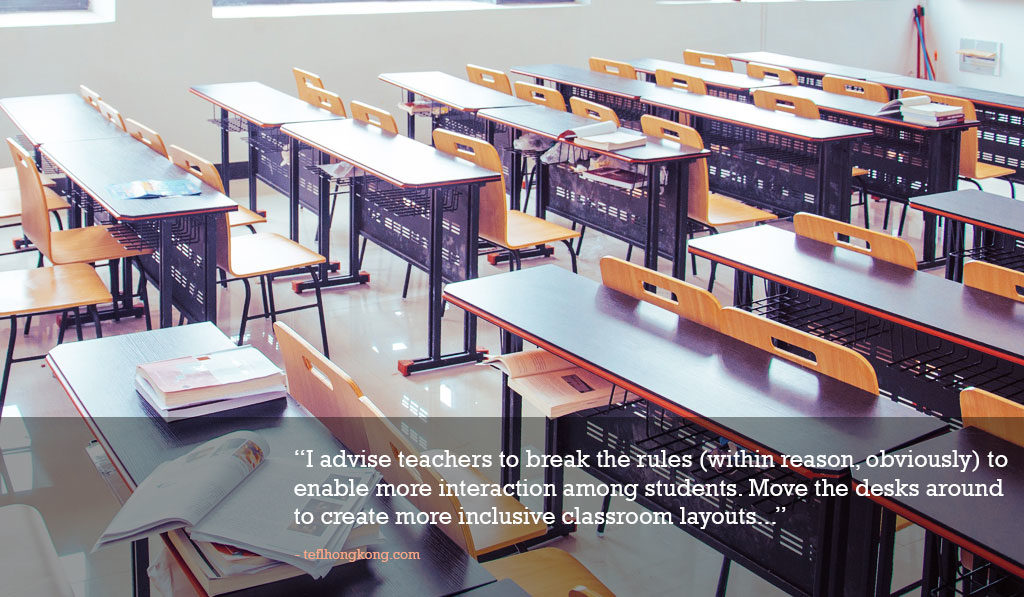
- By: Tom Garside
- In: Teaching Skills
Most language classrooms around the world are not ideal for communication between students to take place. They typically contain rows of desks facing the teacher, students sitting individually or in pairs, with up to 50 students in the room for a lesson.
However, this does not mean that communicative techniques and methods cannot be used to good effect. With a shift in point of view, and some simple techniques, every student can have the chance to speak out during a typical 40-50 minute language lesson.
Here are some principles to follow when bringing interaction into the large-group classroom:
1. Don’t blindly follow traditional pedagogy
Working in an established school, it is easy to fall into habits that you know are not in the best interests of your students, because that is what is expected by the school’s principal, head of department, or simply the wider cultural beliefs about education in the place where you are working.
These are the main three factors that indirectly inhibit communicative activity in language classrooms the world over. However, the greatest direct effect on communication comes from the teaching methodologies that you employ during class time.
I advise teachers to break the rules (within reason, obviously) to enable more interaction among students. Move the desks around to create more inclusive classroom layouts – a horseshoe shape, circle of desks or even no desks at all, with most of the furniture pushed to the side of the room.
The rows of students typically found in high school classrooms inhibit interaction between different members of the class, so change that.
The more you work different layouts into your teaching routine, the more your learners will come to expect the couple of minutes of furniture moving before and after class (it pays to put the classroom back the way you found it!).
Get students moving around the room talking to each other, play games to support the material from the textbook, and encourage them to speak out and make mistakes – that’s part of the confidence-building that learning entails.
2) Change the physical environment
It’s not just the seating arrangements that can empower students to communicate – other aspects of the classroom can get them up and mixing, sharing ideas and gathering ideas to discuss.
Posters, discussion prompts and stimulating pictures can bring out more language if stuck on walls, motivating students to get up and gather around specific areas of the classroom. This breaks the ‘bums on seats’ routine of the traditional education approach, and can result in more communicative opportunities (with careful monitoring, of course).
Also, reward sheets (score cards stuck at the front of the room), with stars awarded for communicative competencies such as confidence, initiative, willingness to try new language out, participation, most questions asked in the lesson, etc., can motivate students to go further than simply answering the questions in the book one by one. Reward effort and willingness to interact – not just the accuracy of what is said, or the number of correct answers given.
3) Develop communicative classroom management routines
Perhaps the biggest obstacle to communication in a large group of students is the amount of individual student talking time that is possible – how can every student speak in a class of 50 during a 45-minute lesson?
With some simple grouping techniques, and your movement around the classroom to confirm that everyone is staying on-task, interaction can shoot up with minimal effort.
- Do the maths: a class of 40 students, split into groups of four (a manageable group size, where everyone can have a turn) becomes ten groups to monitor, with ten individuals speaking at the same time.
- Assign roles to the group members (students 1 and 2 in each group are on the ‘agree’ side, for example, and students 3 and 4 disagree with a speaking prompt), means that the chance for sitting out quietly is cut in half.
- Add some pre-discussion preparation time (in English, of course) and you have 20 pairs of students who have to use English to prepare their points before doing the task itself.
- Again, the more you task the students with interactive work, the less speaking you will do, and the more interaction will happen. You just have to keep your ears open and make sure everyone is doing what they are supposed to.
Another way of grouping students, along with some movement of tables and chairs, is to have four or five ‘stations’ of tables pushed together.
- Prepare copies of four or five pictures, comic strip panels, sets of questions, or even cut-up sections of a long reading text.
- Put different pictures / texts on each station and have students cycle around them in large groups (numbered group 1, group 2, 3, 4, etc), looking, reading or answering questions as they go.
- After 3 or 4 minutes at each station, and when all students have seen all the parts, recombine the groups as 12345, 12345, 12345, with one member from each of the original groups discussing what they saw, read or worked with.
- Each original group will have a slightly different idea based on the order they saw the prompts, so more discussion can be generated from different views of the same material.
- Finding creative ways to group and regroup students in 4s, 5s and even 6es, can increase the eventual communication that happens towards the end of a lesson.
Conclusion:
These are just a few ideas for how to increase interaction in a typical, traditional classroom. Don’t be afraid to break the sit-down-and-shut-up expectations of your school; embrace the changes to the classroom that you can play with – the students may resist at first, but don’t give up!
The fun and bubbling interaction that comes out of this more flexible way of teaching is its own reward, and eventually your learners will come to look forward to what will happen next lesson. Stick to your guns, even with your senior school staff, and the results should speak for themselves.
Further Reading: How to teach your students to listen with purpose
Please Share:This article was originally published on November 19, 2018 and was last updated on January 28, 2019.
Courses We Offer:

1. CertTESOL: Certificate in TESOL
A level 5, initial teacher training qualification for new and experienced teachers, enabling you to teach English anywhere in the world. The course is equivalent to Cambridge CELTA.
Learn More
Developed by our Trinity CertTESOL experts, for a comprehensive, self-paced learning experience. Earn an internationally recognized certificate and master essential teaching skills, accessible globally 24/7.
Learn More